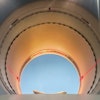While PET and MRI work well together in guiding surgery for children with refractory epilepsy, PET may have an edge in several areas in evaluating these patients, according to a new study from Harvard Medical School and Children's Hospital Boston.
Concordant PET and MRI can predict a greater likelihood of a child being seizure-free after surgery. Conversely, patients without concordant findings have a lower likelihood of surgical success, and, in these cases, PET is better than MRI in identifying patients who may benefit from surgery. The study was presented by lead author Dr. Katherine Zukotynski at the recent SNM annual meeting in Toronto.
In children with epilepsy, FDG-PET is already a well-validated method to localize an epileptogenic focus. The aim of Zukotynski's study was to determine the role of combined imaging with PET and MR in evaluating these patients.
Epilepsy rates
Approximately 1% of the population suffers from epilepsy, and the spectrum of pathology that can result in seizures is broad. Intractable epilepsy does not improve or result in more or less severe seizures with medication. Zukotynski cited statistics indicating that approximately 20% of children with epilepsy have a form of the condition that is refractory to medical intervention, and those cases can benefit from surgical intervention.
The surgical success rate for epilepsy is in the range of 50% or greater, she added, when success is defined by a patient being seizure-free for two years from the date of surgery. Presurgical localization of an epileptogenic focus is the key.
"Usually the children who are referred for presurgical evaluation because of epilepsy undergo a complex evaluation that includes clinical evaluation, as well as [electroencephalography (EEG)] monitoring and imaging, both anatomical and functional," Zukotynski said. "MRI can find important anatomical detail, but functional imaging may add additional information in the case of abnormal MRI or may show abnormalities even in the face of a normal MRI."
Ictal and interictal SPECT are commonly conducted to show perfusion abnormalities, whereas FDG-PET can detect metabolic abnormalities.
PET versus SPECT
In children with intractable epilepsy, PET's resolution is "superior to SPECT, and, if you can't get a good ictal SPECT study, interictal PET may be helpful," Zukotynski added.
With that background, the study was designed to assess FDG-PET's role in the preoperative evaluation of children and young adults with intractable seizures, and, in particular, to quantify any additional benefit of PET compared to MRI in these cases.
The researchers conducted a retrospective review on 46 children between 1 and 21 years with seizures who had received brain MRI scans and who were referred to the facility's division of nuclear medicine for a brain FDG-PET scan between June 2004 and June 2008.
Prior to the PET scan (Advance NXI, GE Healthcare, Chalfont St. Giles, U.K.), patients were asked to fast for four hours, after which they were injected with 5.55 mBq/kg of FDG, with a minimum dose of 18 mBq and a maximum dose of 370 mBq. Three-dimensional images were obtained 40 to 60 minutes after the uptake period.
MR images were taken on a 1.5-tesla scanner in multiplanar, multisequence format.
Patient evaluation
During the time of the study, all patients had a complete presurgical evaluation, including PET and MRI, before undergoing resection of an epileptogenic focus.
"In terms of preoperative findings, we showed that PET demonstrated localizing findings in 39 of the 45 patients [86%]," Zukotynski said. "MRI showed localizing findings in 32 [70%] of patients."
Concordant PET and MRI findings, in which abnormalities on MRI matched abnormalities identified on PET, were identified in 29 (63%) of the patients. No localizing findings were identified in either MRI or PET in four (9%) patients.
In terms of surgical outcome, 24 (52%) of the 46 patients who underwent surgery were seizure-free on follow-up. Regarding localizing findings, 22 of 39 (56%) with localizing PET findings were seizure-free on follow-up, while 18 of 32 (56%) patients with localizing MRI findings were seizure-free on follow-up.
Concordant results
"Subjects with concordant PET and MRI findings had the best outcome -- 18 of 29 [63%] were seizure-free after follow-up," Zukotynski said. "Subjects with nonconcordant PET and MRI -- meaning that the PET findings and MRI findings did not agree -- did not do so well. Of the 17 patients who were nonconcordant, only six [35%] were seizure-free at follow-up."
Of those six patients, four patients were identified by PET exclusively, while the other two patients had no localizing findings on either PET or MRI.
In addition, there were no subjects identified on MRI who were seizure-free postoperatively and did not have localizing findings on PET.
Concordant PET and MRI identified 18 of 24 (75%) subjects who were seizure-free after surgery. PET without MRI findings identified four of 24 (17%) patients who were seizure-free after surgery.
Study conclusions
"In children and young adults with refractory epilepsy, concordant PET and MRI predict a high likelihood of postoperative seizure-free status," Zukotynski concluded. "Subjects without concordant PET and MRI findings have a lower likelihood of seizure-free postoperative outcome, and in subjects with nonconcordant PET and MRI findings, surgical resection at the site identified by PET is associated with a higher likelihood of seizure-free status."
Zukotynski cited a couple of limitations in the study. There was a limitation in terms of subject follow-up, particularly patients who had surgery most recently. Also, the role of ictal and interictal SPECT was not included in the analysis.
By Wayne Forrest
AuntMinnie.com staff writer
July 2, 2009
Related Reading
3-tesla MRI both challenges and rewards pediatric radiologists, December 2, 2008
3-tesla MRI superior to 1.5-tesla MRI in epilepsy evaluation, October 1, 2008
Study shows benefits of very delayed cerebral FDG-PET imaging, December 21, 2007
PET helps predict surgical outcome in refractory epilepsy patients, December 13, 2007
MRI's clinical role expands with new expectations, March 1, 2007
Copyright © 2009 AuntMinnie.com




















